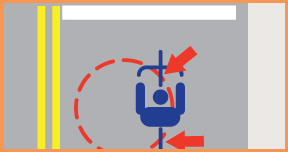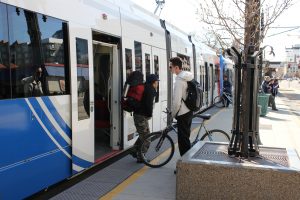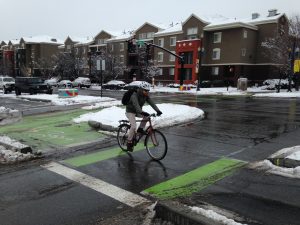Picking routes
The route you drive may not be the best one to bike. Salt Lake City’s grid and multi-use trails offer plenty of options to match your riding style.
Some cyclists prefer quiet neighborhood streets, while others like the speed of main roads. Neighborhood streets are calmer but may require waiting to cross busy roads. Arterials with bike lanes offer a more direct path and dedicated bike space.
If you’re new to city biking, take time to explore what feels best for you. The Salt Lake City Bikeways Map is a great tool to help you plan your route.
When selecting a route, you may wish to consider:
- Traffic speed and volume.
- Available multi-use or mountain bike trails.
- Intersections and crossings — both for safety, and for approaches that give you the right-of-way.
- Traffic signal timing.
- Hills — and particularly steep grades.
- Shade trees, especially in the summer.
Getting a green
Bicycles are vehicles under Utah law and must follow the rules of the road, including stopping at red lights.
If there are motor vehicles also waiting at the red light — in a travel lane going the direction you want to go, you will get a green light when it is your turn. Although bicyclists often run red lights, this is a considerable source of animosity between motorists and bicyclists. You are an ambassador for bicyclists’ rights to be on the road. As a matter of bicycling ethics, bicyclists should obey the law.
However, if there is no motor vehicle waiting at the signal with you, you may be frustrated that the light will not turn green for you. At such traffic signals, bicyclists can often trigger the green light — if you know where to position your bicycle.
Video detection
Look for small cameras near the traffic signal. These are designed to detect vehicles, including bikes, in the travel lane or bike lane. Avoid waiting in right-turn lanes — cameras often ignore that area. If you’re not detected, try moving to the center of the through lane.
Loop detection
Look for circular or rectangular wire patterns in the pavement — these are metal-detecting loops. To trigger them, position your wheels or crank directly over the wires or along the edge of the loop. If you have metal cleats, placing one right on the loop can also help. Contrary to the urban myth, your weight doesn’t matter — modern signals don’t use pressure plates. In fact, Salt Lake City removed its last pressure-based sensors decades ago. It’s all about metal detection now.
Timed detection
During rush hour, most traffic lights in the City are timed by a computer, independent of vehicle detection.
Bikes on transit
Bicycles are permitted on all TRAX and Frontrunner trains, at all times of the day, subject to space limitations. All bus routes except Paratransit and Ski buses have bike racks. The Utah Transit Authority provides more information.
Winter biking
It’s warmer than sitting on a ski lift!
Salt Lake City’s mild valley conditions make for reasonable bicycling on most winter days. Winter bicyclists will want to be careful not to overdress; you’ll warm up as you pedal. Dress in layers so you can adjust for temperature. A thin balaclava for under your helmet in highly recommended. You will also want to have good windproof gloves and footwear.
Consider hand / foot warmers (as used by skiers) for extra-cold days. Check out this video for tips on dressing for winter bicycling from a “hard-core” bicyclist in Chicago — a woman who dresses in ordinary street clothes appropriate for the office environment while bicycling in zero degree (Fahrenheit) temperatures.
Also, this video created by our very own Salt Lake City Bicycle Collective offers good advice for winter cycling.
Yes, there are studded tires for bikes
Pay attention to snow and black ice (clear ice that is not easy to see) on roads. Studded tires, available at local bike shops, provide good traction on icy days.
Keeping going on bad air days
If air quality is a concern, filter masks are available as well, and may be available at local bike shops.


